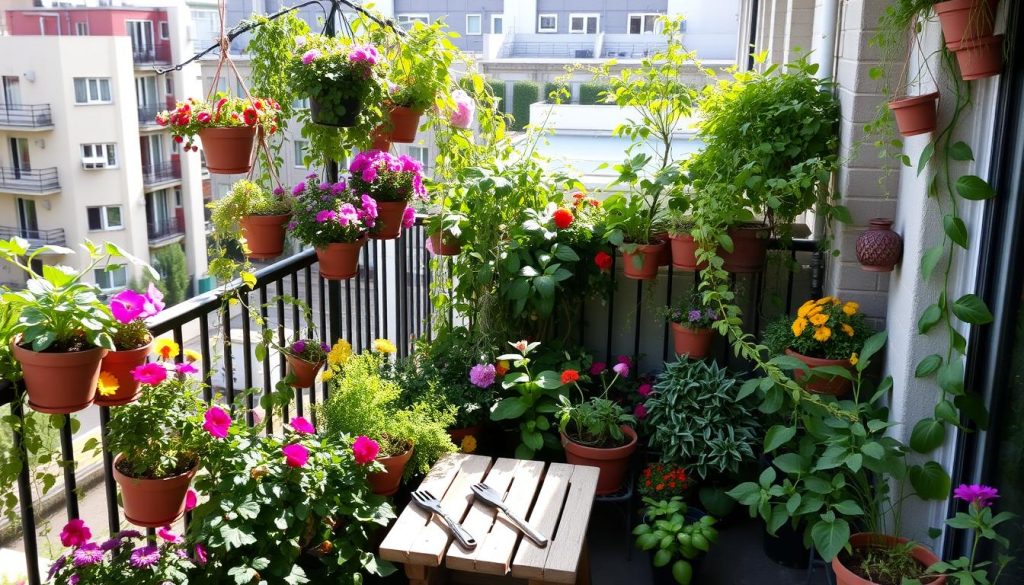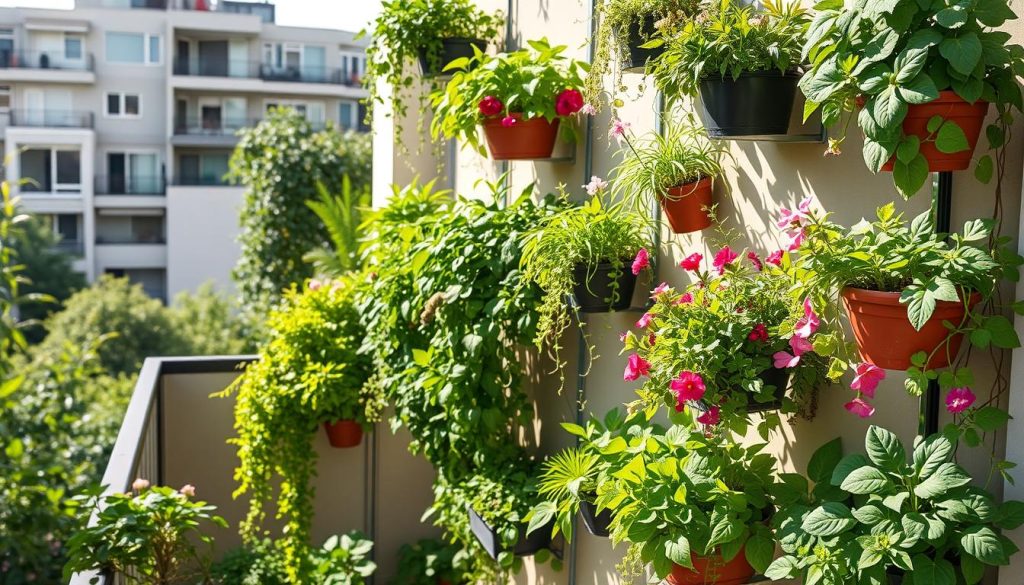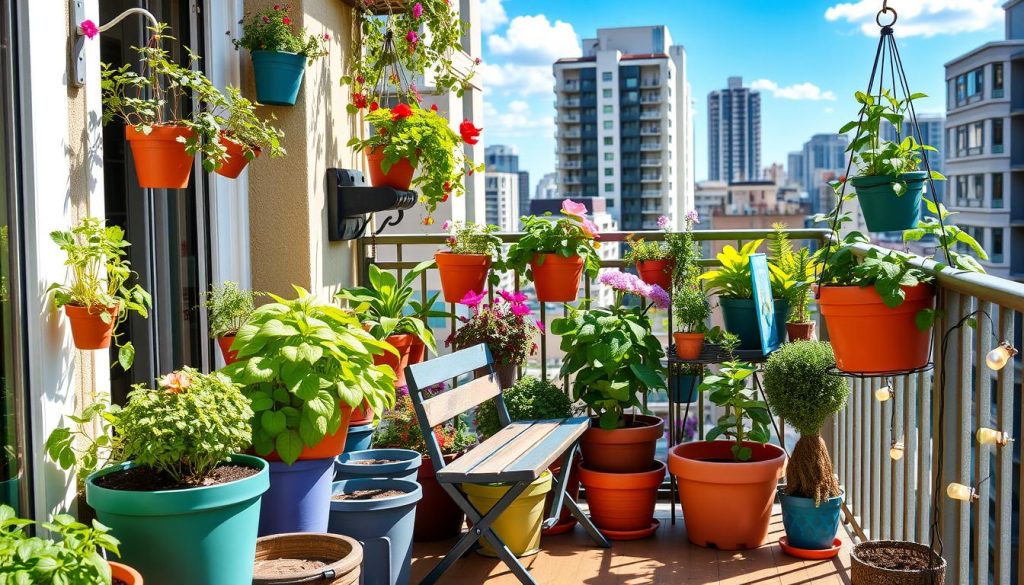Turning your balcony into a garden oasis is a great goal for city folks. You can grow many plants like veggies, herbs, and flowers on your balcony. But, it’s key to know the special challenges of balcony gardening first.
Start by learning about your building’s safety rules and weight limits. Balconies must hold 60 pounds per square foot for gardens. If your balcony gets windy, you might need to move plants or add a wind screen.

Then, check how much sun and water your balcony gets. Plants in full sun might need water twice a day in summer. Plants in shade need less sun. Knowing your balcony’s climate helps pick the right plants and water them right.
Key Takeaways
- Understand your building’s safety codes and weight restrictions for balconies
- Assess your balcony’s sunlight exposure and water access to select suitable plants
- Choose compact plant varieties that thrive in containers and maximize your limited space
- Utilize the “Thriller, Spiller, Filler” container gardening technique for aesthetic appeal
- Ensure your containers have drainage holes to prevent waterlogging and root rot
Understanding Your Balcony Space Limitations
To make the most of your balcony for gardening, you need to know its limits. This includes weight capacity and building rules. Every detail of your balcony matters for a healthy garden.
Weight Capacity Considerations
Most safety codes say balconies must hold at least 60 pounds per square foot. This means your containers, soil, plants, and decor can’t weigh too much. Choose light containers and use soil-less mixes to keep the weight down.
Space Assessment and Planning
Look at your balcony’s size and shape to plan your garden. Think about the floor space, vertical areas, and any blocks to your design. This will help you use your balcony space well.
Building Regulations and Permissions
Check with your condo or apartment manager about balcony gardening rules. Some places have rules on plants, designs, or weight limits. Following these rules makes gardening on your balcony easy and worry-free.
Choosing the Right Container Types
Container gardening is great for balconies, window boxes, or patios. The right container makes a big difference. You need durable materials and practical designs for a successful urban garden.
Think about the weight capacity of your containers. Choose lightweight options like plastic, fiberglass, or fabric grow bags. They won’t weigh down your balcony or patio. Terracotta pots are pretty but can be too heavy for some spaces.
- Plastic containers are a popular choice for their durability and affordability.
- Fiberglass pots offer a modern, sleek look and are highly resistant to weathering.
- Fabric grow bags are a space-saving option that allow for excellent drainage and air circulation.
Window boxes are perfect for small spaces. They fit on railings or ledges, making it easy to grow herbs, flowers, and veggies.
Make sure your containers have drainage holes. This stops waterlogging and lets plants breathe. Self-watering pots are also good, keeping soil moist and cutting down on watering.
Choosing the right containers is key for a beautiful and productive urban garden. Whether it’s a balcony, window boxes, or a patio, the right containers make all the difference.
Mastering Sunlight Assessment for Balcony Gardening
Balcony gardening needs a good grasp of sunlight patterns for plant success. Knowing if your balcony gets north, south, east, or west light is key. This helps pick the best plants and grow a vibrant urban garden.
North-Facing Balcony Solutions
North-facing balconies get less direct sunlight, perfect for plants that like shade. Grow leafy greens like spinach, kale, and arugula here. They need 4-6 hours of sunlight daily. Use LED grow lights for 12-16 hours to help plants grow well.
South-Facing Garden Options
South-facing balconies get lots of direct sunlight, great for many plants. Grow herbs, tomatoes, and sun-loving flowers here. Remember, these plants need consistent soil moisture to do well in the sun.
Dealing with Partial Shade Areas
Balconies facing east or west get partial shade. Choose plants like Swiss chard, lettuce, and some flowers for these spots. Watch the sunlight and adjust your plants to ensure they grow well.
Understanding your balcony’s sunlight is crucial for a thriving garden. By knowing the sun exposure, you can pick the right plants. This way, your balcony garden will flourish, meeting the needs of your plants.
Smart Water Management Systems
Managing water well is key for a successful garden, whether it’s in a container, urban, or micro setting. Using smart watering methods helps keep your garden moist without wasting water.
Think about getting a drip irrigation system or self-watering pots. They make sure your plants get the right amount of water, even when it’s windy or hot. Drip irrigation systems save water and focus on the roots. Water storage pots with a double-bottom design also keep the soil moist.
- Use saucers or trays under your containers to collect excess water and prevent spills.
- Water your plants more frequently in windy or hot weather to compensate for increased evaporation.
- Regularly test the soil moisture and adjust your watering schedule as needed to maintain optimal conditions.
Smart gardening tech, like soil sensors and automated watering systems, makes managing water easier. These tools use real-time data for precise watering. This way, your plants get what they need without wasting water.
Selecting Climate-Appropriate Plants
Choosing the right plants for your balcony is key to success. Think about sunlight, wind, and temperature to make your garden thrive. This way, you can grow a lush garden that makes your space beautiful and fruitful.
Heat-Tolerant Plant Options
For sunny balconies, pick plants that love the heat. Succulents like echeveria and jade plants are great because they store water. Tropical plants, such as hibiscus and bougainvillea, also do well in the sun and add beauty.
Cold-Hardy Varieties
Choose plants that can handle cold if your balcony is cooler. Hardy herbs like rosemary and thyme are good choices. So are cool-season veggies like kale and spinach. This way, your garden stays vibrant even in the cold.
Wind-Resistant Species
Strong winds can be tough on balcony plants. For windy spots, pick plants that can handle gusts. Ornamental grasses and shrubs like lavender are great for adding structure and beauty.
By picking plants that fit your balcony’s climate, you can create a stunning garden. Try different plants to find the best mix for your balcony.
Vertical Gardening Techniques
Looking to make the most of your small balcony? Vertical gardening is the way to go! It lets you grow a garden up and down, not just side to side. With the right methods, you can turn your balcony into a green paradise.
Vertical gardening saves space, letting plants grow up instead of out. It also sparks your creativity by using unusual spots for plants. Plus, it cuts down on weeds, pests, and diseases since plants are off the ground.
- Use trellises, wall planters, hanging baskets, and tiered shelves for multi-level gardens.
- Grow climbing plants like pole beans or vines to use vertical space.
- Try living walls or vertical herb gardens for looks and function.
Vertical gardening means better sunlight for plants, leading to healthier growth and more food. It also helps the environment by cooling buildings, blocking noise, saving energy, and supporting wildlife. With the right techniques, your balcony can become a lush vertical garden oasis.

Essential Tools and Equipment
Balcony gardening needs a few key tools for your plants to do well. You’ll need basic gardening tools and special irrigation gear. The right tools can greatly improve your urban gardening.
Basic Gardening Tools
First, get the basics. A hand trowel for planting and pruning shears for trimming are must-haves. Also, a watering can helps with targeted watering. Choose tools that are small but do a lot, saving space on your balcony.
Irrigation Equipment
Good water management is key for container gardens. Think about a drip irrigation system or self-watering devices. They help your plants get the right moisture without wasting water.
Support Structures
To use your balcony space well, get trellises, cages, and stakes. They support climbing plants, tall veggies, and flowers. These structures keep plants from spreading or falling over.
With the right tools and equipment, balcony gardening becomes easier. Whether you’re growing a container garden or trying vertical gardening, these items will help you succeed.
Soil and Fertilization Strategies
Creating a thriving container garden starts with the right soil and fertilization. Whether you’re into urban, micro, or container gardening, knowing about soil and nutrients is key. It can greatly impact your gardening success.
Begin with a high-quality, well-draining potting soil made for containers. Don’t use regular garden soil, as it can compact and harm plant growth. Add organic matter like compost or slow-release fertilizers to give your plants the nutrients they need.
- Use a balanced, high-nitrogen fertilizer (24-8-16) monthly for lush foliage and growth.
- Also, add an organic, non-water-soluble fertilizer that lasts 2-3 months for long-term nutrients.
- For tomatoes, use a water-soluble fertilizer with a balanced ratio (18-18-21) for roots and blossoms.
- Think about adding lime to your soil mix to balance pH and provide calcium and magnesium.
For starting seeds, choose a high-quality seed starting mix, like Jiffy Seed Starting Mix, for better germination and growth. As plants grow, move them to larger containers with a mix of slow-release organic and quick-release non-organic fertilizers for the best results.
By following these soil and fertilization tips, you’ll be on your way to a thriving container garden. Whether you’re growing urban greens, micro veggies, or a variety of plants in a small space, these strategies will help.
Creating an Edible Balcony Garden
Turn your balcony into a garden full of fresh food. It doesn’t matter if you have a small or big space. With container gardening and planning your herbs, you can grow your own food easily.
Container Vegetables
Choose the right veggies for your balcony. Go for compact tomatoes, peppers, lettuce, and bush beans. They grow well in small spaces and give you lots of fresh food.
Herb Garden Planning
Herbs are a key part of any balcony garden. Basil, thyme, and mint add flavor and beauty. Plan your herb garden well to get the most from your space and keep the soil healthy.
With edible landscaping, veggies in containers, and a good herb garden, your balcony will be a green paradise. Enjoy the fun of gardening in the city and taste the freshness of your own food.
Wind Protection and Microclimate Management
Balcony gardening in cities comes with its own set of challenges. Wind can damage plants and make containers fall over. But, there are ways to overcome these issues and make your balcony a green haven.
Using trellises, screens, or big plants as wind barriers is a smart move. These can block the wind and protect your plants. Choose heavy containers or secure light ones to keep them from moving in the wind.
Also, consider the microclimate of your balcony. This includes the direction it faces, nearby buildings, and the soil. For example, a north-facing balcony gets less sun and is cooler. A south-facing one gets more sun but can be hot and dry. Choose plants and care for them based on these conditions to help them thrive.
With the right wind protection and understanding your balcony’s microclimate, you can have a successful urban garden. A bit of creativity and focus on details can turn a small outdoor space into a vibrant, productive garden.
Seasonal Maintenance Tips
To keep your balcony garden thriving, adjust your care based on the seasons. Each season has its own needs to ensure your plants grow well all year. This includes spring prep, summer care, and winter protection.
Spring Preparation
When spring arrives, it’s time to get your garden ready. Start by cleaning your containers and removing dead leaves. Then, refresh the soil with compost or fertilizer. This is a great chance to add new plants, making your balcony a colorful oasis.
Summer Care Routines
In summer, watering your plants daily is crucial. This is especially true on hot, dry days. Regular pruning and deadheading will keep your plants blooming. Watch for pests and diseases, and use organic solutions to fix any problems.
Winter Protection Methods
When winter comes, protect your plants. Move sensitive plants indoors or use frost covers. Water less as plants go dormant. Proper care will help your garden survive the cold and bloom again in spring.
Always check your plants for stress or disease signs. Adjust your care as needed. This way, your balcony garden will stay vibrant and productive all year.
Space-Saving Design Solutions
Turning a small balcony into a lush oasis is possible with small space gardening. Use vertical gardening and smart storage to make the most of your space. This way, you can create a beautiful and functional outdoor area.
Choosing multi-functional furniture is a smart move. Look for a bistro table that folds up or a bench with hidden storage. These options save space and keep things neat.
- Use wall-mounted planters or hanging baskets for vines and flowers.
- Try tiered planters to increase your growing area without taking up more space.
- Arrange plants to add depth and interest. Place taller plants at the back and smaller ones in front.
Balconies face challenges like strong winds, intense sun, and shallow soil. Choose plants that thrive in your climate and use efficient watering systems. This way, you can grow a vibrant micro garden.

With creativity and planning, even a small balcony can become a beautiful part of your home. By using vertical gardening, multi-functional furniture, and smart storage, you can enjoy the benefits of gardening in a small space.
Pest Control in Urban Gardens
Keeping your balcony or urban garden healthy means fighting pests. It’s important to check your plants often for pests or diseases. Look out for aphids, caterpillars, and flea beetles, which can harm your plants.
To keep pests away, use physical barriers like netting or row covers. These barriers can stop pests from reaching your plants. Also, attract beneficial insects like ladybugs and provide them with homes. Planting herbs and marigolds can confuse pests and protect your garden.
- Use organic or low-toxicity pest control methods for urban gardens.
- Find out what pest you have and choose the right way to control it.
- Keep the soil healthy to prevent pests from coming.
- Change what you plant each year to avoid diseases.
- Remove or spray off pests when you can.
With these pest control strategies, you can keep your balcony or urban garden healthy and pest-free.
Budget-Friendly Gardening Approaches
Turning your balcony into a garden doesn’t have to cost a lot. You can create a beautiful space with a bit of creativity and smart choices. Use items like coffee tins, buckets, or old crates as planters. They’re unique and won’t empty your wallet.
Start seeds instead of buying plants to save money. This way, you can grow your own plants and enjoy the savings. Join plant swaps or community gardens to share resources and ideas.
Make your own potting soil and fertilizers to cut costs. Choose plants that are easy to care for and give a lot back. Herbs, leafy greens, and small veggies are great for balcony gardens.
With a bit of creativity and elbow grease, you can enjoy gardening without spending a lot. Focus on smart, affordable ways to create a beautiful green space right at your door.
Conclusion
Balcony gardening is a great way to connect with nature in cities. It lets you understand your space, pick the right balcony gardening plants, and use smart urban gardening tips. Regular care, creative space use, and adapting to seasons are key for success.
By using the right strategies and creativity, your balcony can become a lively part of your home. This guide has given you important tips for balcony gardening success. Every urban garden is different, so be ready to try new things and adjust as needed.
Starting your urban gardening journey is exciting. You’ll turn a small space into a green oasis. Enjoy growing your own food, herbs, or flowers. The joy of small space gardening will make your life better and connect you more with nature. Celebrate your wins and enjoy the many benefits of balcony gardening.